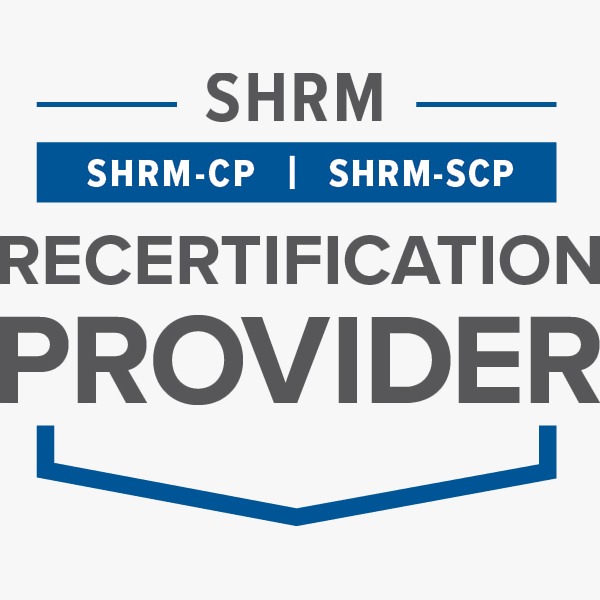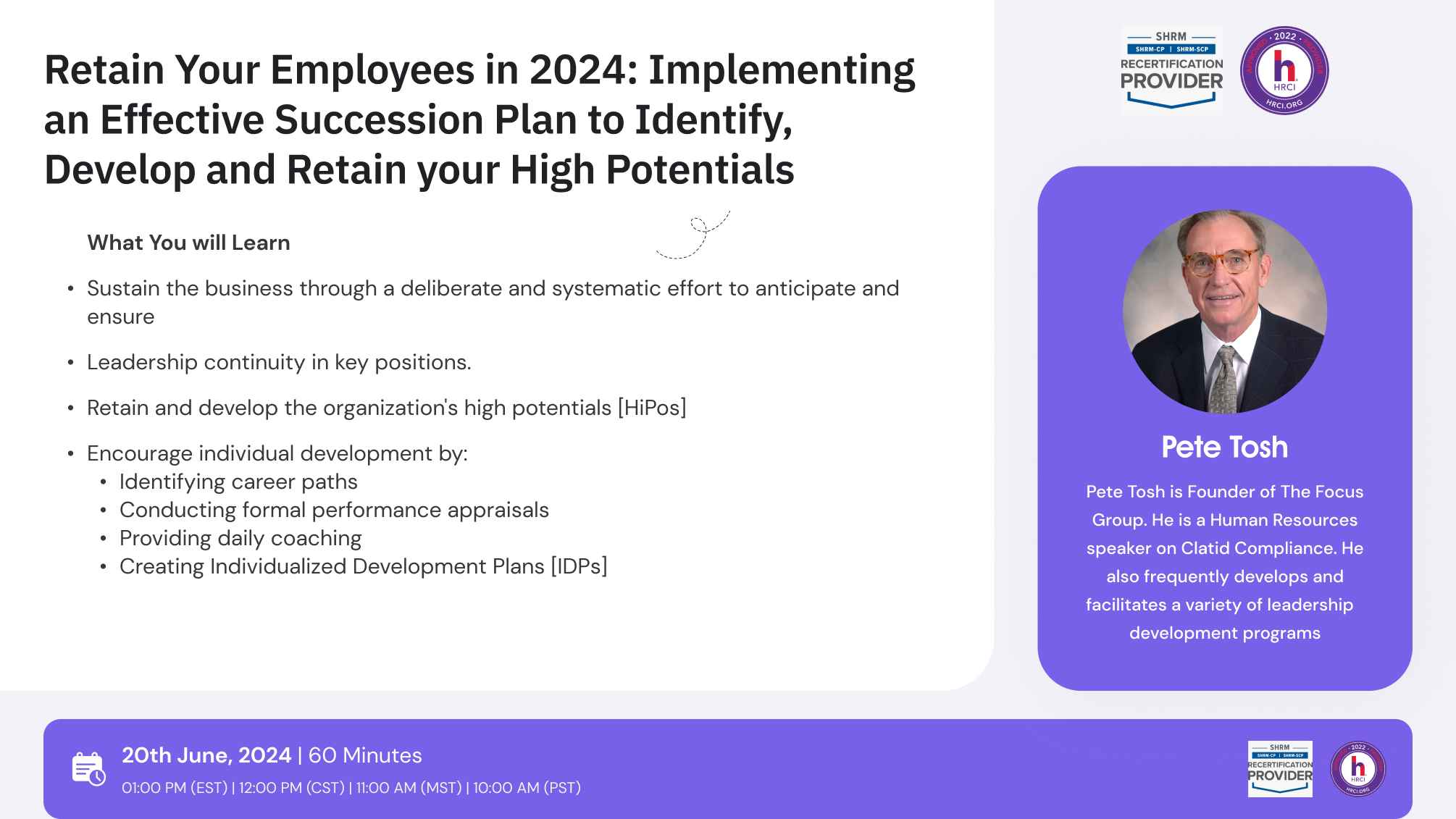Welcome To Biggest Online compliance Platform
Human Resource & Payroll
I. Succession Plan Defined
A deliberate, systematic process of anticipating the need for talent and ensuring that the necessary employee competencies and experience are available when needed. A strategic approach for avoiding an undersupply of talent, enhancing the organization’s current talent pool and meeting the organization’s future needs.
II. Objectives and Benefits of Succession Planning
Sustain the business through a systematic effort to ensure leadership continuity in key positions. Attract, retain & develop high potentials [HiPos]. Encourage HiPos development by:
- Identifying career paths
- Conducting performance appraisals
- Providing daily coaching
- Creating Individualized Development Plans [IDPs]
- Holding Talent Review meetings
III. Tools and Processes Commonly Utilized for Developing and Implementing
- Self-appraisals and career goals
- Performance appraisals, 360 feedback and ratings
- Assessment instruments
- GE grid
- Individual development plans [IDPs]
- HiPo talent development interventions
- Talent review meetings
IV. What an Organization, its Leaders and the Program Participants Need to Do To Achieve an Effective Plan
What an organization needs to do:
- Supply funding/budget
- Establish a sharp vision and guidance for the program
- Develop a formal, written program
- Announce the objectives of the program to all employees
- Ensure that all leaders and managers support the program
What the leaders need to do:
- Have job descriptions developed for their teams
- Conduct effective, formal performance appraisals
- Identify employee developmental areas
- Share their knowledge and experience
- Involve employees in more of the leader's responsibilities
- Facilitate the completion of IDPs for all Hi Pos
What the program participants need to do:
- Conduct self-appraisals
- Identify their desired career paths
- Learn as much as they can about potential future assignments
- Perform to their capabilities
- Complete their IDPs
- Develop the employees reporting to them – so they have successors
V. Potential Measures of the Program’s Success
- Whether there is, at least, one successor for each key position
- Having developmental goals and IDPs established for each successor
- Determining how much of their manager’s job the successors can perform
- Determining whether successors can perform their manager’s jobs when they are unavailable and evaluating their performance during those times
The primary objectives for and deliverables from a Succession Planning program are to:
- Sustain the business through a deliberate and systematic effort to anticipate and ensure
- Leadership continuity in key positions
- Retain and develop the organization's high potentials [HiPos]
- Encourage individual development by:
- Identifying career paths
- Conducting formal performance appraisals
- Providing daily coaching
- Creating Individualized Development Plans [IDPs]
During Succession Planning Programs:
At the macro level the organization is proactively determining:
- the talent needed in the future
- the talent it has now
- where there are talent gaps
- the initiatives necessary to close those gaps
At the micro level, the organization is addressing - for each of its key positions - questions such as:
- what the organization would do if it had to fill the position tomorrow
- whether there is, at least, one successor who could immediately perform the duties of the position
- if there is no successor ready now, what will need to be done to enable the best internal candidate to be ready and when can he/she be ready?
- can the organization afford to wait or would it be better to recruit a successor, etc?
Experience has found the following two processes to be highly effective in enabling organizations to have the talent they need when it is needed:
#1 Performance Management and/or 360 Feedback Processes - through which the organization is able to:
- evaluate its employees’ current performance – based on documented, objective, performance and achievements
- assess its employees’ advancement potential
- determine its employees’ current readiness for advancement
- obtain from its employees self-appraisals identifying their developmental needs and preferred career plans
- meet its bench strength needs by initiating Individual Development Plans and experiences - at least, for its A Players and/or High Potentials - such as:
- special or stretch projects assignments in other depts./job rotations
- ‘try-out/popcorn stand’ slots mentors
- formal training and development initiatives
- fast track programs with exposure to other functions, intense coaching, etc.
- track their A Players’ and High Potentials’ performance and advancement - potential against a Performance-Potential Grid
#2 Talent Review Meetings – during which the executive team in a disciplined fashion asks each leader to report on the status of the Individual Development Plans for each of their A Players and High Potentials ensure that each A Player and High Potential is receiving regular coaching and is actively involved in opportunities that will help retain them while accelerating their development drives the organization past ‘business as usual’ by ensuring that its future needs for human capital are identified and will be satisfied when the time arrives – as it will. Succession Planning initiatives also increase the levels of engagement and performance of your A Players and High Potentials – the talent your organization will most need in the future.
Fortune 500 companies and small family businesses alike share a business need - insuring that they have the talent necessary to effectively lead their organizations in the future. One of the most significant contributions a leader can make is insuring his/her business’ continuity and sustainability - by having employees who are willing and capable of filling each key position with a plan for doing so when the need arises.
Succession Planning is a:
- deliberate, systematic process of anticipating the need for talent and ensuring that the
- necessary employee competencies and experience are available when needed in the future
- a strategic approach for avoiding an undersupply of talent, enhancing the organization’s
- current talent pool and meeting its future needs
Not having a Succession Plan can be costly and sometimes disastrous; it is expensive to recruit, interview, select, on-board and train a new leader and significant opportunity costs are incurred when a key job is not being performed.
- HR Professionals New to the Field - seeking a comprehensive view of the subject with multiple application initiatives
- Experienced HR Professionals - seeking a refresher
- Leaders and Managers - interested in understanding both how a Succession Plan benefits an organization

Pete Tosh is the Founder of The Focus Group, a management consulting and training firm that assists organizations in sustaining profitable growth through implementing strategic HR initiatives, maximizing leadership effectiveness, and strategic planning. He collaborates with Clatid Compliance to provide practical training and guidelines on Human Resources, leadership, and growth in business.
Pete has worked closely with the leadership teams of organizations such as Exxon, Brinks, EMC, State Farm, Marriott, N.C.I. YKK and Freddie Mac. He holds a B.A. degree in Psychology from Emory and Henry College and Master's degrees in both Business Administration and Industrial Psychology from Virginia Commonwealth University. He is also co-author of Leading Your Organization to the Next Level: the Core Disciplines of Sustained Profitable Growth. His firm has provided consulting and training services to manufacturing and service organizations across the U.S., Canada, Europe, and the Middle East.

SHRM -
PearlEducation is recognized by SHRM to offer Professional Development Credits (PDCs) for the SHRM-CPSM or SHRM-SCPSM. This program is valid for 1.0 PDCs for the SHRM-CPSM or SHRM-SCPSM. For more information about certification or recertification, please visit - portal.shrm.org.

HRCI -
This webinar has been approved for 1.0 HR (General) re-certification credit hours toward California, GPHR, HRBP, HRMP, PHR, and SPHR recertification through the HR Certification Institute.
The use of this seal is not an endorsement by the HR Certification Institute of the quality of the activity. It means that this activity has met the HR Certification Institute’s criteria to be pre-approved for re-certification credit.
Sign up now on pearlacademy.net. Visit pearlacademy.net/webinar to discover a wide range of webinars from industry specialists. Tick on either ‘live webinar’ or ‘on-demand’, and simply click on ‘buy now’ to get enrolled.
You can refer Pearl Education to anyone in your social circle. Explore your industry with your colleagues by getting them signed up on Pearl Education today!
Go for the topic of your keen interest on pearlacademy.net. Tick on ‘live webinar’ and get enrolled! Easy registration, transparent transaction.
You can request for an on-demand webinar that records the live webinar for you. After the webinar ends, you will have full access to the webinar’s recording. You can also explore Pearl Education offline to order your webinar DVDs, flash drives and transcripts.
If you can’t attend the live webinar, simply go for the ‘on-demand webinar’ for the same price! Now, the live webinar recording will be saved in a cloud storage for you to access anytime from anywhere.
Pearl Education offers both hard and soft copies of the webinars. It contains all the highlights as well as comprehensive descriptions of the webinar, so you never miss out a single detail.
After attending the live webinar, your certificate will be emailed to you. You can download it and add more charm to your professional score.
At the end of each webinar, you have the opportunity to interact with your industry experts, where you will get answers to all your queries.
Can’t attend the live webinar? Pearl Education has got you covered! You can always switch to the on-demand webinar from your portal. You can also get your hands on the webinar’s DVD/flash drive and transcript. So order them now!
Pearl Education brings a variety of options for offline learning. Order your DVDs, flash drives or transcripts now to have a lifetime access to Pearl Education webinars. You can also go for on-demand recordings. Download and watch it anytime from anywhere in the world!
